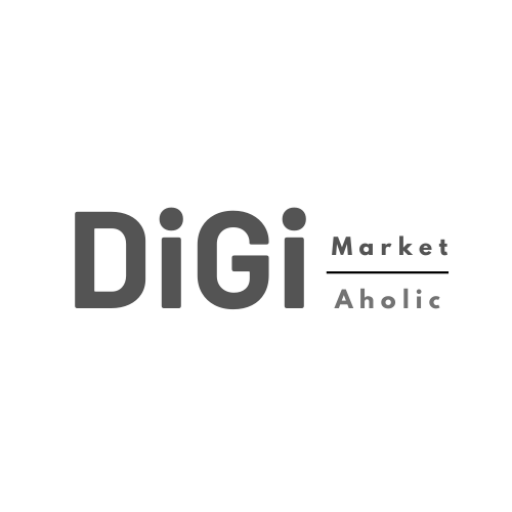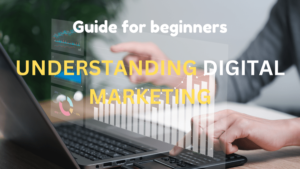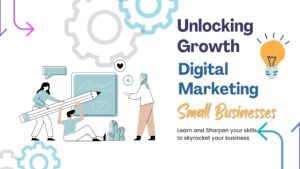Learn digital marketing from scratch with this free beginner’s guide. Master SEO, content marketing, social media, email marketing, and paid advertising to boost your online presence.
What You Will Learn From This Free Beginner’s Guide
This free beginner’s guide will teach you the basics of online marketing, including how it differs from traditional methods. You’ll explore key online marketing channels like SEO, content marketing, social media, email, and paid advertising. You’ll also learn to create a simple marketing strategy, identify your audience, set goals, and implement practical tactics, from optimizing website content to running basic ads. Finally, you’ll discover how to overcome common beginner challenges and find resources for further learning.
Introduction to Digital Marketing?
Internet marketing refers to the use of online platforms and technologies to promote products, services, or brands. Unlike traditional marketing, which relies on physical media like TV, print, or billboards, online marketing leverages tools such as online advertising, social media marketing, and email marketing.
For example, when you see an ad on Facebook promoting a new pair of sneakers or receive a promotional email offering a discount on a service, you’re interacting with electronic marketing efforts. online marketing allows businesses to connect with potential customers directly, personalize experiences, and measure the success of their marketing campaigns in real-time. This is a key part of online business marketing.
This form of marketing offers an exciting advantage over traditional marketing methods—its ability to reach a global audience instantly. While TV ads or billboards might only target specific geographic locations, internet advertising can cross borders and be accessed by anyone with an internet connection. This is a core part of internet marketing.
How Digital Marketing Differs from Traditional Marketing Methods
Traditional marketing methods, such as print ads, TV commercials, and radio spots, have been the backbone of advertising for decades. However, these methods have some limitations, including high costs, limited tracking capabilities, and difficulty in targeting specific audiences. In contrast, online marketing allows businesses to reach precisely the target audience they want by using paid ads on platforms like Google, Instagram, and LinkedIn. This is a key element of internet strategies.
Additionally, online marketing provides businesses with detailed marketing analytics to measure the success of their marketing campaigns, enabling them to tweak their marketing strategies for better results. Whether it’s through tracking website traffic, conversion optimization, or customer engagement, internet marketing techniques offer a more cost-effective and measurable approach compared to traditional marketing methods. This is a crucial aspect of data-driven marketing.
Forms of Digital Marketing
1. Search Engine Optimization (SEO)
Definition:
SEO (Search engine optimization) is the process of optimizing a website to rank higher in search engine results, aiming to increase organic traffic by improving visibility, user experience, and relevance to search queries. This is relevant to e-commerce SEO.
Purpose:
To help businesses attract their target audience through search engines without relying solely on paid search ads. This is important for achieving a good Google ranking.
Subcomponents of SEO
1.1. On-Page SEO
On-page SEO involves optimizing individual web pages to improve their search engine rankings and user experience. This often involves the use of SEO tools.
Key Factors:
Title Tags: Short, descriptive titles including target keywords to help search engines and users understand the page content. This is a core part of SEO strategies.
Meta Descriptions: Brief summaries of page content that encourage users to click.
Headings (H1-H6): Properly structured headings that outline content hierarchy and improve readability.
Content Quality and Relevance: High-quality, original, and engaging content that satisfies user intent.
Keyword Optimization: Strategic, natural placement of primary and related keywords throughout the content. This relates to content marketing.
Image Optimization: Use descriptive file names and alt text and compress images to improve page speed.
URL Optimization: Short, descriptive URLs incorporating keywords for better indexing and user understanding.
Internal Linking: Connecting related pages within the website to enhance navigation and distribute link equity.
Mobile-Friendliness: Ensuring pages are responsive and perform well on mobile devices.
Page Speed: Optimizing site load time to improve user experience and rankings.
User Experience (UX): Creating intuitive layouts and designs that engage users.
Schema Markup: Adding structured data to help search engines display rich snippets in results.
Content Freshness: Regularly updating content to maintain relevance and improve rankings. This contributes to content optimization.
Readability: Using clear language, short paragraphs, and proper formatting.
HTTPS: Securing the site with SSL for user trust and ranking benefits.
1.2. Off-Page SEO
Off-page SEO refers to activities performed outside the website to build its authority and trustworthiness. These activities are considered SEO best practices.
Key Factors:
Link building: Acquiring quality backlinks from authoritative and relevant websites.
Social media marketing: Promoting content and engaging audiences on platforms like Facebook, Twitter, and LinkedIn.
Brand Mentions: Gaining brand awareness on third-party sites, with or without backlinks.
Forum Participation: Contributing valuable insights on industry-relevant forums and communities.
Influencer marketing: Collaborating with influencers to promote content and generate backlinks.
Directory Submissions: Listing your business in reputable directories to improve Local SEO.
Local Citations: Consistent mentions of your business name, address, and phone number (NAP) in local directories.
Guest Blogging: Publishing content on other websites in exchange for backlinks.
Social Bookmarking: Sharing web pages on platforms like Reddit or StumbleUpon for increased visibility.
Content Marketing: Promoting content off-site to drive website traffic and build authority. This involves using content marketing strategies.
Types of Backlinks:
Natural/Editorial Links: Links earned organically through high-quality content. This is a key component of organic SEO.
Manual Outreach Links: Links acquired through direct outreach to website owners.
Self-Created Links: Links added by the website owner (e.g., forums, directories). Use with caution as they may be low value.
No-Follow Links: Do not pass link equity but can drive website traffic.
Do-Follow Links: Pass link equity and improve rankings (default link type).
Anchor Text: Using appropriate anchor text is important for SEO.
Contextual BackLinks: Contextual backlinks are links embedded naturally within relevant text on a webpage, providing valuable context for both users and search engines. While non contextual backlinks are not within the main content like body.like non contextual backlinks are sidebar links, footer links, directory links, blog comments links.
1.3. Technical SEO
Technical SEO focuses on optimizing the backend of a website to ensure search engines can crawl, index, and rank it effectively.
Key Factors: Site speed and mobile-friendliness are crucial. Other factors include crawlability, indexability, site architecture, HTTPS, structured data, canonicalization, redirects, crawl errors, broken links, and XML sitemaps.
1.4. Local SEO
Local SEO focuses on optimizing a website for location-based searches to attract customers in specific geographic areas.
Key elements: Google My Business (GMB) optimization, NAP consistency, local keywords, and customer reviews.
1.5. Advanced SEO Techniques
For experienced marketers, advanced techniques according to latest trends in internet marketing will help you to refine SEO strategies.
Key elements: Content clusters, competitor analysis, voice search optimization, and AI-driven SEO.
2. Content Marketing
Content marketing focuses on creating valuable content to engage and educate your target audience. This can include blogs, videos, podcasts, infographics, and more. The key to successful content marketing is creating content that answers your target audience’s questions and solves their problems. This is a key component of online marketing techniques.
Storytelling plays a crucial role in content marketing. By crafting compelling stories, you can create a deeper emotional connection with your target audience and enhance brand awareness.
3. Social Media Marketing (SMM)
Social media marketing involves using platforms like Facebook, Instagram, LinkedIn, and Twitter to promote your business and connect with your target audience. SMM can be organic (unpaid posts and engagement) or paid (using social media ads on various platforms). This is a valuable component of online advertising.
Organic SMM focuses on building a loyal customer base through regular social media engagement, posting relevant content, and participating in conversations.
Paid SMM uses paid ads to boost visibility and drive website traffic or online sales.
Example: A clothing brand might use Instagram to showcase new products, running targeted Instagram marketing campaigns to reach users interested in fashion. They might also explore influencer marketing to further enhance their brand awareness.
4. Email Marketing
Email marketing is a direct way to reach your target audience. Building an email list allows you to send newsletters, updates, and promotional emails to your subscribers. A successful email marketing campaign provides value while promoting your products or services. This can be streamlined with marketing automation.
Engaging Newsletters: Send valuable content like industry insights, tips, or exclusive offers. These can be automated using marketing automation tools.
Promotional Emails: Encourage immediate action, such as discounts or limited-time offers. These are often part of broader email campaigns.
Example: Many businesses use welcome emails to engage new subscribers and nurture them toward making a purchase.
5. Search Engine Marketing (SEM)
SEM (Search Engine Marketing) involves paid search advertising on search engines like Google. It allows you to target specific keywords and appear at the top of search results for relevant queries. This is a core part of online marketing.
Google Ads: The primary tool for managing SEM campaigns. Advertisers bid on keywords to show their display ads in search results.
SEO vs. SEM: SEO focuses on organic traffic, while SEM focuses on paid advertising. Both marketing strategies can work together for optimal online visibility.
Example: A business selling fitness equipment might use SEM to target keywords like “best home gym equipment” to drive website traffic to their site. This is a common application of pay-per-click (PPC) advertising.
Note: PPC (Pay-Per-Click) advertising is a core component of SEM (Search Engine Marketing). It allows businesses to bid on keywords and appear at the top of search results through paid campaigns.
5.1. Pay-Per-Click Advertising (PPC)
Pay-per-click (PPC) advertising is a paid marketing strategy where advertisers pay each time their ad is clicked. PPC ads appear on search engines like Google, and on platforms like Facebook and Instagram. PPC is effective for businesses seeking quick results, as ads can appear at the top of search results instantly. Marketing automation platforms can help manage these campaigns.
Google Ads: A popular platform for both SEM and PPC advertising. Advertisers bid on keywords to have their ads appear on search result pages.
Social Media PPC: Paid ads on social media platforms allow for precise ad targeting to specific demographics.
Example: A local restaurant might use Google Ads to appear when people search for “best pizza near me” in their area.
6. Affiliate Marketing
Affiliate marketing allows you to earn commissions by promoting products or services from other businesses. You can find affiliate programs through platforms like Amazon Associates, ShareASale, and Commission Junction. By promoting products on your website or social media, you earn a commission when someone makes a purchase through your referral link. This is a strategy for marketing growth.
Example: Bloggers often use affiliate marketing links in their content, recommending products they love and earning a commission when readers buy through those links, contributing to online sales.
7. Mobile Marketing
Mobile marketing focuses on reaching users via smartphones and tablets. With the increasing use of smartphones, it’s essential for businesses to create mobile-friendly content and marketing campaigns. This is essential for customer acquisition.
SMS Marketing: Sending text messages to customers with offers, reminders, and news.
Push Notifications: Alerts sent to a user’s device, prompting them to take action.
Mobile App Ads: Ads placed within mobile apps.
Why Mobile Matters: The shift towards mobile-first experiences means that businesses need to ensure their websites and marketing efforts are optimized for mobile users.
Example: A retail brand might send SMS coupons to customers who opted into their list, driving website traffic to their mobile app or website.
8. Analytics and Data
Marketing analytics and data are essential for tracking the success of your internet marketing efforts. Tools like Google Analytics data help you monitor user behavior on your website, track conversion rate, and analyze campaign performance. This is a key part of assessing marketing performance.
Key Digital marketing metrics: Conversion rate optimization, bounce rates, and social media engagement.
Improvement: By analyzing marketing data, you can make informed decisions to optimize marketing campaigns and improve Marketing ROI. This is a core aspect of data-driven marketing.
Example: Using Google Analytics data, a business can see that their visitors from Facebook ads are more likely to make a purchase than visitors from organic search, allowing them to allocate their marketing budget more effectively. This relates to understanding marketing funnel stages.
Developing a Digital Marketing Plan
Understanding Your Target Audience
Importance of Knowing Your Target Audience: Understanding the target audience is crucial for any marketing campaign. Creating buyer personas and understanding customer insights are essential. This is a key aspect of marketing segmentation.
Tools for Market Research: Tools like Google Analytics, Facebook Insights, or surveys can help research target audience preferences.
Setting Marketing Goals
Clear Objectives: Setting specific, measurable marketing goals is essential. Examples: increasing website traffic, boosting online sales, or growing social media followers. This relates to brand positioning.
Foundation of Success: Clear marketing goals provide direction and focus for marketing campaigns.
Choosing the Right Channels
Social media, email marketing, or search engine optimization? Choosing the right channels depends on your marketing goals.
For example: Social media is often used for engagement, email marketing for conversion optimization, and search engine optimization for visibility. This is a key consideration within your marketing funnel.
Learning by Doing: Practical Steps for Beginners
Start with a Small Project
Practical Experience: Beginners can start by creating a blog or a social media account and experimenting with SEO, content creation, and running ads.
Importance of Hands-On Learning: Hands-on experience accelerates learning.
Explore Free and Affordable Tools
Free Tools: Tools like Canva, Mailchimp, Google Ads, and Hootsuite offer valuable practice and learning opportunities.
Run a Simple SEM Campaign
Google Ads Basics: Setting up a Google Ads account and running a small-budget SEM campaign with targeted keywords is a great starting point.
Overcoming Common Challenges
Limited Marketing Budget
Organic Strategies: Using free tools and organic strategies such as SEO and content marketing can effectively drive website traffic even with a limited budget.
Examples: Using social media platforms to gain visibility is a low-cost method.
Time Constraints
Creating a Learning Schedule: A manageable learning schedule is key to consistent progress. This is an important part of campaign management.
Feeling Overwhelmed
Focus on One Area: Beginners should start with one aspect of online marketing (e.g., SEO or social media marketing) and expand later.
Resources to Learn Digital Marketing
Free Courses and Tutorials
Platforms like Google Digital Garage, HubSpot Academy, and YouTube marketing tutorials offer beginner-friendly online marketing lessons. This includes learning about video marketing.
Books and Blogs
Beginner books and blogs focusing on foundational electronic marketing concepts are valuable resources.
Communities and Networking
Joining communities, forums, and networking groups provides opportunities to learn from others and ask questions.
Measuring Success and Improving
Tracking Marketing Performance
Tools like Google Analytics, SEM metrics, and social media insights are essential for tracking the success of marketing campaigns.
Adapting Based on Results
Analyzing marketing data and adjusting marketing strategies accordingly is crucial for improving Marketing ROI.
Scaling Your Digital Marketing Skills
Specializing in a Niche
Focusing on niches like e-commerce marketing or SEO allows for deeper expertise in a specific area.
Staying Updated
Staying current with the latest digital marketing trends is crucial for long-term success.
Freelancing or Starting a Business
Turning online marketing skills into a freelance career or business is a viable option. Freelance platforms are fiverr, upwork etc.
Conclusion
Key Takeaway: Internet marketing combines creativity and strategy and is accessible to anyone willing to learn.
Next Steps: Starting small and building skills consistently is the best approach.
Encouragement: The electronic world is full of opportunities for those with online marketing skills.




